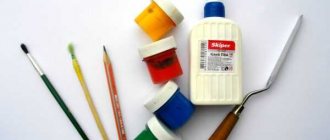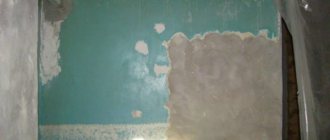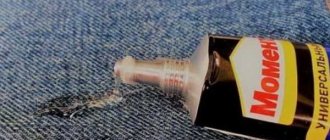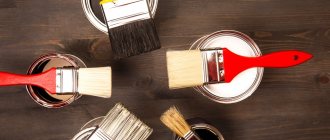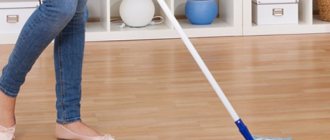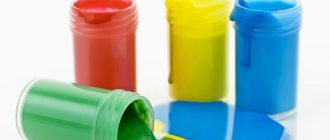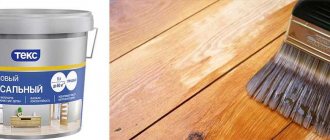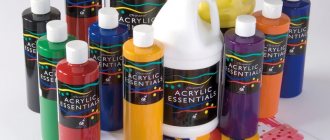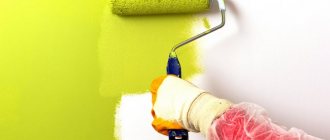In this regard, it is difficult to clean any surfaces from such a coloring substance. It is recommended to do this before the stain dries.
It is recommended to deal with old marks using solvents. There are nuances to removing acrylic paint from various surfaces.
In this article we will tell you how and how to remove acrylic paint from various surfaces.
How to remove fresh traces?
So, how to remove acrylic paint? It is recommended to wipe off the dye stain as quickly as possible. To prevent paint from drying quickly, treat the surface with cold water.
Then you need to use the following available tools:
Sunflower oil with soap .
You need to generously moisten the stain with oil and leave for 20 minutes. After this, it is necessary to brush the surface with a previously prepared warm soapy solution. After cleaning, rinse the product with clean water.- Isopropyl alcohol . After treating the surface with cold water, you need to generously moisten the stain on it with isopropanol. You need to wait about 5-10 minutes, then wipe off the mark with a stiff brush. After cleaning, you need to wash the product with water.
- Window cleaner . After treating the product with cold water, it is necessary to sprinkle it generously with window cleaner. You need to wait about 5 minutes, then use a stiff brush to wipe away the trace of the dye. After treatment, the surface is thoroughly washed with warm water and soap.
One option to combat fresh stains is to use hairspray.
It is used liberally to treat acrylic stains. After 10 minutes, the substance should begin to peel off. Dirt must be wiped off with a sponge. If necessary, you can scrub it with a brush.
What methods of removing varnish are not applicable to plastic?
The fact is that this material is synthetic and has enormous absorbing abilities, therefore, the varnish that got on it almost immediately penetrated deep into the surface.
Using mechanical cleaning, you will simply scratch the plastic surface, since, as mentioned, the varnish has already been absorbed.
It is also strictly forbidden to use heat treatment, since the plastic can simply melt even faster than the varnish itself.
Therefore, before you wipe off wood varnish from plastic, take into account all the features of this material and try not to spoil it.
Some craftsmen try to use solvents in case of such contamination, but this should not be done. Firstly, the plastic itself may begin to dissolve and defects form on it, and secondly, if it is colored, then there is a high probability of color distortion, that is, an ugly stain will remain.
How to clean old stains?
You can fight stubborn stains with baking soda or vinegar . Solvents that are more effective include acetone and turpentine. You can also use kerosene.
Soda
Baking soda is a product that has a good cleaning effect. The substance is safe for humans.
To clean acrylic paint from products, you must use soda powder:
- sprinkle it liberally on the trace of the dye;
- soak the sponge with water;
- vigorously begin to rub soda into the dirt, use a stiff brush to enhance the effect;
- wash off the baking soda from the surface with warm water.
A combination of baking soda, dish soap and lemon juice will make it easier to remove stubborn acrylic stains from items.
How to wipe with vinegar?
This product contains acetic acid - it is a good solvent . You need to first rinse the surface with cold water and then soak the dirt on it with vinegar. You can warm up the solution a little.
The area treated with vinegar must be thoroughly wiped with a sponge. Then you need to wash the surface with warm water. Working with vinegar should only be done with gloves and a respirator.
Acetone
This substance is used to dissolve dyes and varnishes . It is recommended to use pure acetone to remove acrylic from various surfaces, and not the one that is included in nail polish removers.
It is necessary to thoroughly saturate the paint stain on the product. Then you need to wait 5 minutes for the acetone to begin to dissolve the old paint. It is necessary to wipe off the dirt with a sponge. You can use a brush.
How to remove stains with turpentine?
This substance dissolves well not only dyes, but also varnishes. Turpentine can be used to remove old paint.
It is necessary to moisten the acrylic stain on the product with it and allow the solvent to absorb well into it . After this, use a sponge or brush to thoroughly rub the turpentine into the stain.
After treatment, the surface should be washed with water. Turpentine must be kept away from sources of fire.
Kerosene
This hydrocarbon mixture can be used as a solvent for dyes . Kerosene does a good job of corroding old acrylic marks.
It is necessary to moisten the dirt generously with the mixture. It is important to wait about 5 minutes for the stain to soak in the kerosene. After this, you can begin to scrub off the dirt with a sponge.
If the stain is stubborn, then you need to use a stiff brush. After treatment, you need to thoroughly rinse the surface with warm soapy water and then with clean water.
Features of removing various types of paints
Today, many paints and varnishes are produced, varying in chemical composition. Each type of dye has its own removal methods.
Pay attention to: How to remove old paint from bathroom walls yourself
Widely used water-based enamel is removed with a soap solution. Add washing powder or dishwashing detergent to a bucket of water. Then the solution is applied to the dirty area for 30 minutes. Then you need to wash off the paint.
Water-based enamel (dried) can be removed by placing the stained product under a hot stream of water (up to +80 degrees). Then the surface is wiped with a rag. If the layer of dirt is thick, use a special solvent “SYNTILOR Hard” according to the instructions. You can also use silicone sealant. There are many options for removing water-based enamel.
Acrylic dyes are difficult to remove with water or heat. Special washing solutions that corrode decorative coatings can successfully cope with the problem.
For items with a non-standard configuration or with a relief coating, cleaning with “liquid glass” will be required. It will quickly loosen a thick layer of enamel, which can be easily removed with a soft brush.
Paint remover SYNTILOR Hard
Special solvents
Both aerosol and combined products are suitable for removing marks on various products. The best option is solvents. But when choosing and using them, one condition must be taken into account.
Such products have a strong odor and have an adverse effect on the skin . Therefore, it is necessary to work with them only with gloves and a respirator.
Solvents can have an aggressive effect on some types of products. This is especially true for fabrics and wallpaper. For such products, it is recommended to select natural rather than chemical solvents.
Video review of remover for acrylic paints:
Top 3 best
Most often, there are 3 such effective means for purifying water from acrylic paint.
WD-40
One of the best products for removing acrylic from various surfaces is WD-40 aerosol. This is a universal remedy. Its base component is white spirit, which is considered the best solvent for dyes.
WD-40 should be used according to the following scheme:
- Use a spatula or scraper to remove some of the paint from the product.
- Treat the trace of the dye with an aerosol.
- Wait at least 20 minutes.
- Wipe the stain with a sponge.
- Scrape off any remaining dirt with a scraper.
- Wash the product with warm water and soapy water.
WD-40 is best suited for removing acrylic paint from plastic, metal, wood and rubber. The price of 100 ml of aerosol is 180-240 rubles .
Denatured alcohol
One of the best remedies is denatured alcohol. This is a three-component substance. It contains three solvents. This is kerosene, as well as methanol and ethanol. 500 ml of denatured alcohol costs about 250 rubles.
The product should be used according to the following scheme:
- Moisten the dye stain generously with liquid.
- Wait about 5-10 minutes.
- Wipe off dirt on the product with a sponge.
- Wash the surface with warm water.
Denatured alcohol is poisonous . When working with the product, you need to wear not only gloves, but also a respirator. Do not keep denatured alcohol near fire.
White Spirit
The third on the list of the best means for washing acrylic from products is white spirit. This is a gasoline solvent. The product dissolves oil and acrylic paints well, as well as enamels and varnishes. The price of 1 liter of white spirit is 100-110 rubles.
You can remove the coloring matter from the product according to the following scheme:
- Apply white spirit to the stain with a sponge.
- Wait 10 to 15 minutes.
- Wipe the stain with a foam sponge.
- Wash the surface with warm water.
Work with white spirit only in a ventilated area. The product must be kept away from sources of fire. Treating surfaces with white spirit should only be done while wearing gloves and a respirator.
Preparatory operations
In addition to the type of plastic, you should also find out the type of composition with which it was once painted. For example, water-based paint is the easiest to remove. It is enough to heat the surface that has been painted with water-based paint.
For water-based paint, surface temperatures of 60-75°C will be sufficient. Such work must be carried out in the warm season, since with a high temperature contrast, the water-based paint will be removed, but the surface of the plastic product may receive residual deformation.
For other types of paints, washing them by surface heating of plastic is ineffective. Therefore, the surface of the window and door being prepared for cleaning must be thoroughly cleaned of dust and dirt, and then stocked up with:
- a respirator (in extreme cases, a gauze bandage);
- a set of cotton swabs;
- a brush to remove old paint from a window or the surface of a door leaf.
Work must be performed with rubber gloves, since all solvents are toxic and can provoke the development of skin diseases. The room in which washing work will be carried out must be effectively ventilated.
How to remove it from ceilings, plastic, fabric and other surfaces?
For a specific type of surface, a specific product for removing paint stains is suitable.
| Surface type | Suitable product with brief instructions |
| Plastic | It is recommended to remove dirt with WD-40 aerosol. The plastic should be wiped with a soft sponge treated with this product. Hard brushes can damage the plastic. |
| Textile | Thick fabrics can be cleaned with white spirit, turpentine, vinegar or kerosene. Delicate fabrics should not be stained with solvents. It is better to limit yourself to a soap-soda solution. After processing the fabric, it should be washed thoroughly. |
| Skin of hands | Skin is sensitive to solvents. To remove traces of acrylic from the skin of your hands, you should use alcohol, scrubs, soda with dishwashing liquid, vinegar, and hydrogen peroxide. After treatment, you need to wash your skin with warm water and soap, and then treat it with a moisturizer. |
| Ceiling | It is washed off acrylic paint with a mixture of dishwashing liquid and soap solution. You can use hydrogen peroxide. The ceiling must be treated with a soft cloth. |
| Linoleum | Any solvent is suitable for cleaning. In the process of cleaning the surface, you can use spatulas and scrapers. |
| Tile | Any solvent can be used to clean the surface from dyes. When cleaning, scrapers, spatulas, and knives are used. |
| Glass | For processing, it is recommended to choose white spirit. Knives with sharp blades can be used to scrape off dirt. |
| Wallpaper | Chemical agents are not suitable for cleaning the surface. Natural solvents should be chosen. You can use dish soap and soap. When cleaning, use soft sponges. Do not clean wallpaper with scrapers or hard brushes. |
Features of paint removal
Manipulations associated with cleaning plastic items require a special approach. When they are exposed to fire or hot air, damage to their structure may occur. Therefore, when cleaning the product, you should consider several points:
- The surface of the material is deformed due to mechanical influences. If you use hard metal brushes, the powders will cause abrasions and scratches.
- When in contact with acids, alkalis and other excessively caustic substances, plastic objects are destroyed and lose their performance characteristics.
- It is forbidden to heat it above +80 degrees Celsius. When exposed to high temperatures, the product loses its shape and becomes unsuitable for use.
The process of removing paint requires care. Therefore, before carrying out work, it is necessary to determine what type of material it is.
The mechanical method can damage the surface of the plastic
Methods for determining plastic
There are several options for identifying material. Let's highlight the main methods:
- reading and decoding markings . It is applied to the back of the product. The material is classified by digital designations located in a triangle. So “1” is PET; “2” – polyethylene; “3” – PVC; “4” – polyethylene, but less dense in structure; “5” – polypropylene; “6” – polystyrene;
- igniting the material. For example, PET, when ignited, emits soot and smoke that is pungent in consistency. When burning, polyethylene smells like paraffin. Polystyrene burns brightly, releasing soot, while polypropylene is smokeless. PVC quickly extinguishes, and polycarbonate will fill the air with a “sweet” smell;
- immersion in a liquid aqueous environment. Polyethylene and polypropylene will float. PET and PVC will slowly sink, but polyamide and polystyrene will float for a long time.
Pay attention to: Removing paint and varnish from concrete walls: methods, materials, technology
It is best to identify the material by reading its labeling, and then decide what to use to clean the stain.
Plastic classification
Common mistakes when cleaning products
Some people, when removing dyes from clothes, often rub the area where the stain appeared with a brush. Due to increased rubbing, the material deteriorates and wears out prematurely.
Such a mistake is fraught with deterioration in the color of the clothing and its complete loss of its qualities.
Often, when cleaning any product, circular movements are made . Do not rub the dirt from the center to its edges. Movements should only be made back and forth.
This cleaning error leads to an increase in the size of the acrylic paint stain on the product.
A common mistake is treating the product with boiling water . Before removing the dye, the surface should be moistened with cold rather than hot water. Boiling water may cause the product to lose its shape. This is especially true for clothing and wallpaper.
A common mistake is removing stains with solvents from surfaces that are sensitive to them without first checking their effects. After using chemicals, clothes and wallpaper may be completely damaged.
The main mistake is delay in washing the stain from the dye. It is often impossible to clean dried acrylic paint from the surface of clothing, wallpaper, and ceilings. Such an error may result in the product becoming unusable.
Adviсe
When washing various surfaces from dyes, the following is recommended:
- always check how the chemical behaves on an inconspicuous area of clothing, wallpaper, ceiling;
When working with solvents, always wear gloves and a respirator;- When using chemicals, constantly ventilate the room;
- do not use hard scrapers when cleaning plastic, wallpaper, clothing and ceilings;
- When washing the skin of your hands from acrylic paint, use only natural products and degreasers;
- Pre-wet old acrylic paint stains with cold water before removing;
- To clean windows from coloring substances, choose predominantly white spirit.
It is important to never delay removing the dye . It is recommended to do this within the first hour from the moment the stain was placed on the product. In this case, the contamination must immediately be thoroughly moistened with cold water.
Nothing helps - what to do?
If chemical compounds do not cope, you should turn to silicone sealant. When it turns out to be useless, only radical methods remain. To do this, use sandpaper, various knives and blades. Mechanical paint removal may damage the surface.
If chemical compounds do not cope, you should turn to silicone sealant.
